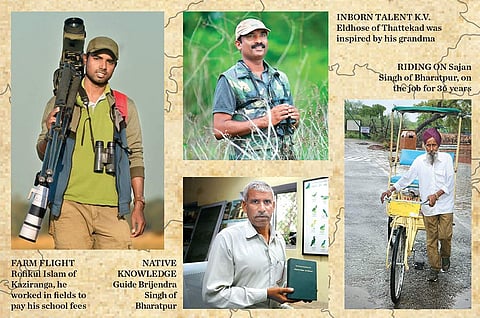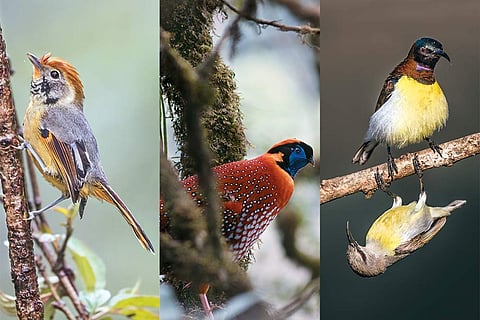Pranjal J. Saikia sniffs rocks and soil for a living and shoots birds for pleasure. The geologist with Oil India Ltd in Jodhpur is a birder and the pastime hooks him like a gateway drug. He takes time out and scours the country for something most people might think is relaxing—watching, photographing and counting birdlife. But this outdoor recreational activity can be as hectic and exhausting as you want it to be.
Something To Crow About
Birding guides, those sharp-eyed experts, can actually show you birds you might pray to see
It is so much fun to watch a plucky birder plotting his next adventure. Pranjal’s first step is to choose a place to go. Not an easy task. Birding in India has reached mysterious patches that never featured high on any bucket list until two decades ago. The uncharted hills and wetlands in the Northeast, the salty flatbeds of the Rann of Kutch, the nooks of the coastal ghats, the crannies of the Himalayas, or the comforting southern greens, backwaters and boondocks. Even popular nature reserves have cottoned on to the value of birders and advertise themselves as birding hubs.
“It is not so often we are fortunate enough to come across birds that exist on the fringes of reality and fantasy, and that is exactly what these singular destinations offer,” Pranjal explains why people like him put their money and time in the line to tick an elusive and exotic bird off their life list. For him, the arduous trek to a remote tree-hugging, outdoorsy land is filled with meaning, as a rare sighting sedates the mind and body, allowing the world to melt blissfully away.

Pranjal’s trips begin with a forecast check, travel and hotel or homestay bookings, and a double-check of the gear (camera, lenses, binoculars, guidebook, camouflage clothes, shoes, anti-leech lotions, energy bars et al). His trusted companions are his binoculars and a camera rigged with a 400mm prime lens and slung around his neck, like a rifle, for “hunting without bloodshed”.
And then he picks a guide whose knowledge determines the success, or failure, of his excursions. Seasoned guides can spot a bird by sound, a skill they have developed after years of training and legwork to learn how to distinguish similar species by their feathers, behaviour or, most importantly, their calls. It is not an easy skill to acquire. Most birds look alike. Every bird has a bill, feathers, two legs, and most of them can fly. But the similarities end there. Even plumages of the same species vary by age, season, sex or location.
The guides employ stealth, surveillance and stakeout—sometimes unethical subterfuges like playing recorded bird songs on Bluetooth devices—to track down unsuspecting birds. They are professionals. Some like Hari Lama of Sattal in Uttarakhand and Assam’s Rofikul Islam and Binanda Hatibaruah can take you at the break of dawn, as it unfolds wreathed in Himalayan mists, across a secret narrow trail bordered by steep drops, fording rivers and over escarpments, to a berry patch bustling with birds. Or, take for instance, Sanjay Sharma of Sultanpur near Gurgaon can show you a hidden waterhole behind an arbour of twisty desert trees in the Aravallis, where birds dash for a drink, dive for a bath.

A Blue-throated Barbet in Rudraprayag
These places are a magnet for hardcore birders, a subset of the larger birdwatching community, who constitute the main clientele of the guides operating individually or for commercial tour companies. Their passion and money support the guides whose earnings range from Rs 150 an hour for a guided rickshaw tour inside Bharatpur to Rs 6,000 a day for a trek inside the tenebrous forests of Mishimi Hills in Arunachal.
Birding is a commercial enterprise, but its size is unknown as the nation’s travel industry doesn’t keep a separate count of people taking tours specifically to watch birds. Guide K.V. Eldhose, 55, of Thattekad Bird Sanctuary in Kerala says he gets a sizeable number of enthusiasts and photographers, especially from IT hub Bangalore. Birding is a trendy hobby primarily among suburbanites eager to get out of their boxed, sedentary existence and indulge in a setting that offers ample opportunities to interact with nature. They are the high-rollers.
Besides, most birders and guides have a spark bird, the one that aroused his curiosity. For Eldhose, it was the Indian Pitta his grandmother could identify from its song. “Every Sunday I would go with my friends to watch birds…and a time came when I could spot and identify 35 species in 30 minutes,” he says. His best moment came when British broadcaster and naturalist David Attenborough was making the BBC documentary Life of Birds in the 1990s. Eldhose’s help was sought to spot the Rufous Woodpecker, which was getting elusive. He didn’t disappoint.

A Bar-throated Siva and a Temminck’s Tragopan in Arunachal; a Purple-rumped Sunbird pair in Bangalore
Most of the guides share a common background. Their early life is set against the backcloth of poverty, but surrounded by nature. Rofikul was literally tied to the yoke as he tilled farmlands in his village near Kaziranga National Park to fund his education. He was drawn to a training programme for guides at the park after his school finals and now works for a tour firm. “It was hard work. I was told bird guides make good money. And money was what I was after,” says the 29-year-old graduate in arts, fluent in English.
Sharma of Sultanpur has a similar tale. A guide for the past 24 years, he had developed in his childhood a love for birds, watching them flock the wetlands while he tended the family farm with his father. An after-school training programme that came with a cash incentive hooked him to birding and guiding for his life. “More people are into birding these days, but there are more photographers than actual birders,” complains Sharma about the urban birding converts drawn in by the visual seductions of Instagram and their Facebook and Twitter feeds.
As a schoolkid, Binanda, now 32, ferried tourists on a rowboat across Maguri Beel abutting his village in Upper Assam’s Tinsukia district. He needed the money to pay his school fees. The sorties paid him back in more ways than one. He always had sharp eyes and ears, loved nature and possessed an inquisitive mind. A chance meeting with an Assamese grassland bird expert changed his life. Today, he is one of the most sought-after guides in Dibru Saikhowa National Park and for tours in Mishimi Hills. “I can tell from the sight and sound if a bird is happy or in trouble,” he says.

Lama, in his 50s, worked as a hotel boy near Chitwan National Park in Nepal in the early 1990s. “I had a knack for birds and would follow the guides into the park, listening as they called out the English names of the species they spotted. I would memorise them. Unfortunately, they were more than unwilling to teach a greenhorn,” he says. But he didn’t give up and got his guide’s licence in 1994. The 1990s were tumultuous times in Nepal with Maoist insurgency at its peak, forcing him to flee to India. The self-taught man is a freelancer now. He is booked for the entire 2019 season.
The late ornithologist, Dr Salim Ali, mentored India’s first crop of guides in the 1970s and ’80s, one of whom is Brijendra Singh, 56. The illiterate cowherd—watching the tamasha of Ali and his team from the Bombay Natural History Society (BNHS) trapping birds on mesh nets and ringing them—“can now identify birds and tell their significance in the ecosystem”. He co-authored a book, Flora Fauna of Keoladeo NP, with Dutch naturalist Jan Hermans.
Ali also got rickshaw-pullers of Bharatpur town trained to serve as guides and tourist transporters inside the park. They are still around. From eight rickshaw-pullers in the 1980s their tribe has increased to more than 100 now. Competition is high but Sajan Singh, who has been ferrying visitors for the past 36 years, makes just about enough to feed his family. The earnings are paltry but Singh, whose family migrated during Partition from Pakistan, is happy.
These guides have built their own brands from the ground up and attracted a more diverse crowd of fans without the help of major marketing budgets. These trailblazers are opening the door to a lucrative, likeable job. And it’s a rare thing to really love what you do.